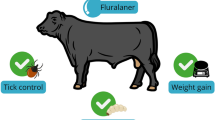Abstract
A case of sarcoptic mange caused by Trixacarus caviae in a conventional guinea pig breeding colony is reported. The infestation was reported in a large colony of guinea pigs during the month of July, 2013 affecting 30 breeder guinea pigs. Severely infested animals were treated individually with subcutaneous injection of ivermectin 1 % w/v (Neomec®) at the rate of 400 µg/kg body weight 10 days apart. Three doses of ivermectin were sufficient to eliminate the parasite which tested negative after 30 days of the first treatment. The entire colony was given preventive dose of ivermectin spray (2 mg/ml solution) following the same schedule. Strict hygienic measures were followed. New hair growth in the severely affected animals was evidenced on 30th day of treatment.



Similar content being viewed by others
References
Ackerman L (1987) Trixacarus caviae infestation in a guinea pig. Can Vet J 28:613
Eshar D, Bdolah-Abram T (2012) Comparison of efficacy, safety, and convenience of selamectin versus ivermectin for treatment of Trixacarus caviae mange in pet guinea pigs (Cavia porcellus). J Am Vet Med Assoc 241(8):1056–1058. doi:10.2460/javma.241.8.1056
FAO monograph 41-3, Residues of some veterinary drugs in foods and animals. Available at: ftp:ftp.//fao.org/ag/agn/jecfa/vetdrug/41-3-ivermectin.pdf or http://www.fao.org/food/food-safety-quality/scientific-advice/jecfa/jecfa-vetdrugs/en/
Fuentealba C, Hanna P (1996) Mange induced by Trixacarus caviae in a guinea pig. Can Vet J 37:749–750
Harikrishnan VS, Ranaraj VR, Fernandez AC (2009) Incidence of Chirodiscoides caviae in laboratory rats-screening, identification and treatment. Scand J Lab Anim Sci 36(2):147–153
Holt DC, Fischer K, Allen GE, Wilson D, Wilson P, Slade R, Currie BJ, Walton SF, Kemp DJ (2003) Mechanisms for a novel immune evasion strategy in the scabies mite Sarcoptes Scabiei: a multigene family of inactivated serine proteases. J Invest Dermatol 121(6):1419–1424
Honda M, Namikawa K, Hirata H, Neo S, Marou T, Lynch J, Chida A, Morita T (2011) An outbreak of Trixacarus caviae infestation in guinea pigs at an animal petting facility and an evaluation of the safety and suitable dose of selamectin treatment. J Parasitol 97(4):731–734
Izdebska JN, Rolbiecki L (2013) Sarcoptic mites (Acari, Sarcoptidae) parasitizing the brown rat Rattus norvegicus (Berkenhout 1769) (Rodentia, Muridae), with a new data for the fauna of Poland. Ann Parasitol 59(3):125–128
Kummel BA, Estes SA, Arlian LG (1980) Trixacarus caviae infestation of guinea pigs. J Am Vet Med Assoc 177:903–908
Mandigers PJ, van der Hage MH, Westerhof I, Dorrestein GM (1993) A field study of the efficacy of ivermectin in propylene glycol in the treatment of mange in guinea pigs [in Dutch]. Tijdschr Diergeneeskd 118:42–46
McKellar QA, Midgley DM, Galbraith EA, Scott EW, Bradley A (1992) Clinical and pharmacological properties of ivermectin in rabbits and guinea pigs. Vet Rec 130(4):71–73
Méabed EMH (2013) Oral ivermectin as a therapeutic agent in patients with scabies. Rawal Med J 38:127–130
Mederle N, Indre D (2009) Trixacarus caviae infestation in guinea pigs case report. Lucrări Ştiinłifice Med Vet XLII 1:101–104
Mircean V, Titilincu A, Băgut T, Dumitrache M (2009) Research on the etiology of skin diseases in laboratory animals. Bull UASVM, Vet Med 66(2):112–118
Singh SK, Dimri U, Ahmed QS, Sayedda K, Singh KV (2013) Efficacy of doramectin in Trixacarus caviae infestation in guinea pig (Cavia porcellus). J Parasit Dis 37(1):148–150. doi:10.1007/s12639-012-0155-7
Walton SF (2010) The immunology of susceptibility and resistance to scabies. Parasite Immunol 32:532–540. doi:10.1111/j.1365-3024.2010.01218.x
Acknowledgments
The author thankfully acknowledges the Director, Pasteur institute of India, Coonoor and Dr K N Venkataramana, Assistant director for providing infrastructure to carry out the work, Dr S Sahu for valuable inputs in correcting the manuscript, Mr N M Ramakrishnan and all the staff members of Laboratory Animal Division for their technical support, Dr S. Islam and Dr N N Barman, CVSc, Khanapara, Assam for their valuable guidance in diagnosis and treatment of the case.
Author information
Authors and Affiliations
Corresponding author
Rights and permissions
About this article
Cite this article
Nath, A.J. Treatment and control of Trixacarus caviae infestation in a conventional guinea pig (Cavia porcellus) breeding colony. J Parasit Dis 40, 1213–1216 (2016). https://doi.org/10.1007/s12639-015-0652-6
Received:
Accepted:
Published:
Issue Date:
DOI: https://doi.org/10.1007/s12639-015-0652-6




